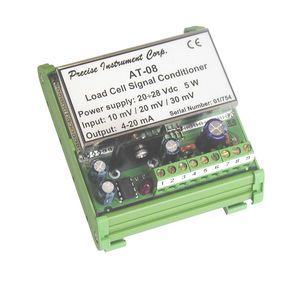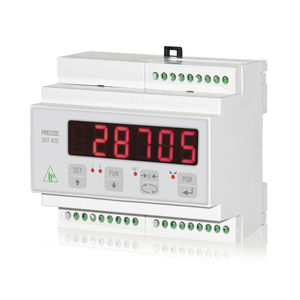
- Products
- Modbus RTU weight transmitter
- Pavone sistemi
Analog weight transmitter DAT 100 Modbus RTUDIN rail mount

Add to favorites
Compare this product
Characteristics
- Output signal
- analog, Modbus RTU
- Mounting
- DIN rail mount
Description
The weight transmitter DAT 100 Analog has high performance and long-term reliability. Configuration and calibration can be set up from the front panel. The small width dimensions allow to place a large number of transmitters inside the electrical automation panels. The weight transmitter DAT 100 Analog has an interface with intrinsically safe barriers for use in hazardous areas. The product can be customized according to customer needs. It has two red status LEDs, 3 mechanical buttons behind the red door and screw terminal blocks.
Technical Specifications
Measuring range: –4 ÷ +4 mV/V
Input sensitivity: 0.02 µV/count
Full scale non-Linearity: <0.01 %
Gain drift: < 0.001% FS/°C
Display: 5 digit, red LED (7 segments), h 7 mm
A/D Converter: 24 bit
Internal Resolution: 16.000.000 points
Trasducer input voltage: 4 V (max 4 cells 350 Ohm)
Frequency signal acquisition: 4 ÷ 123 Hz
Visible resolution (in divisions): 60 000
Divisions value (adjustable): 0.001 ÷ 50
Temperature range: -10 ÷ +50°C (max umidity 85% without condensation)
Storage temperature: -20 ÷ +60 °C
Filter: 0.2 ÷ 20 Hz
Logic output: 2 Solid-state relays, (maximum load 24 Vdc / 100 mA each)
Logic input: 2 optoisolated 24 Vcc PNP (External voltage)
Serial port: RS232C half duplex with ASCII or Modbus RTU protocol, RS485 full duplex with ASCII or Modbus RTU protocol
Analog output Non-Linearity: < 0.03% FS
Temperature drift analog output: < 0.002% FS
Power supply: 24 V c.c. ±10% – power 2 W
Regulatory compliance: EN61000-6-2, EN61000-6-3 for EMC; EN61010-1 for electrical security
Analog output: 16 Bit optoisolated
Catalogs
DAT 100
2 Pages
*Prices are pre-tax. They exclude delivery charges and customs duties and do not include additional charges for installation or activation options. Prices are indicative only and may vary by country, with changes to the cost of raw materials and exchange rates.












